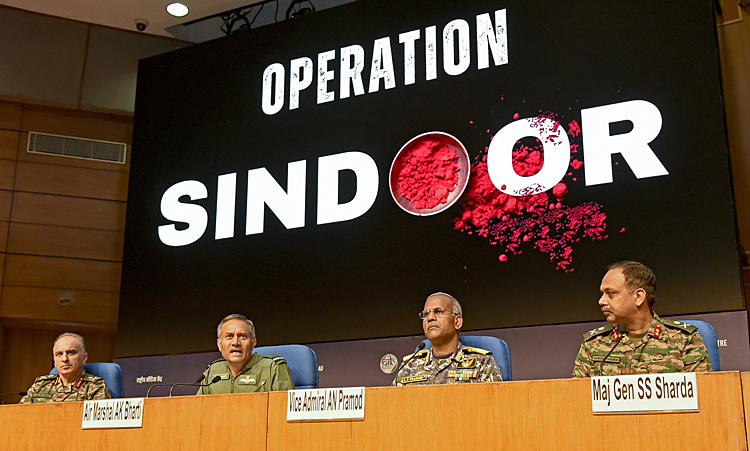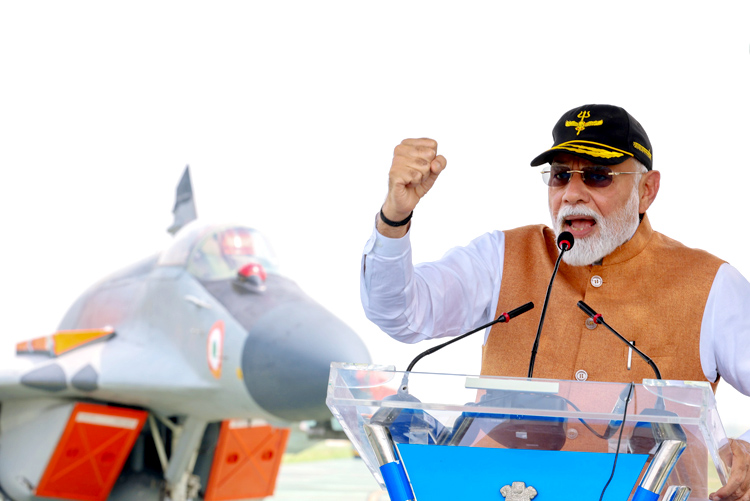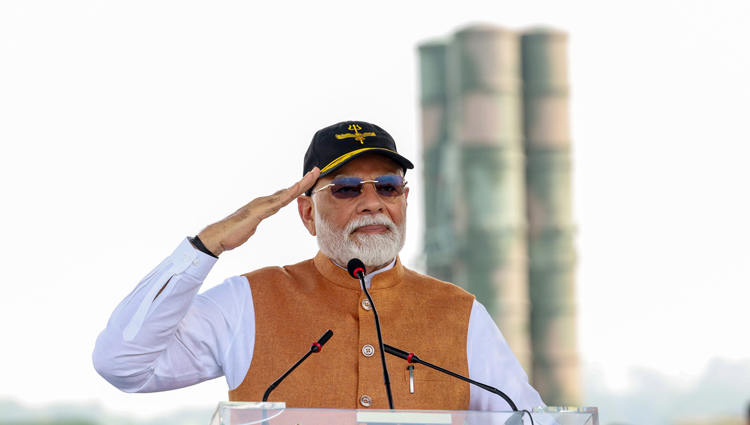INDIAN ARMED FORCES CHIEFS ON OUR RELENTLESS AND FOCUSED PUBLISHING EFFORTS

The insightful articles, inspiring narrations and analytical perspectives presented by the Editorial Team, establish an alluring connect with the reader. My compliments and best wishes to SP Guide Publications.

"Over the past 60 years, the growth of SP Guide Publications has mirrored the rising stature of Indian Navy. Its well-researched and informative magazines on Defence and Aerospace sector have served to shape an educated opinion of our military personnel, policy makers and the public alike. I wish SP's Publication team continued success, fair winds and following seas in all future endeavour!"

Since, its inception in 1964, SP Guide Publications has consistently demonstrated commitment to high-quality journalism in the aerospace and defence sectors, earning a well-deserved reputation as Asia's largest media house in this domain. I wish SP Guide Publications continued success in its pursuit of excellence.
- Appointments Committee of Cabinet approves one-month extension in service of Chief of the Army Staff
- Prime Minister witnesses 'Bharat Shakti' – a Tri-Services Firing and Manoeuvre Exercise in Pokhran, Rajasthan
- Interim Defence Budget 2024-25 — An Analysis
- Union Defence budget 2024
- Indian Army: In quest of greater firepower and policy recommendations for gaps
- Indian Army Annual Press Conference 2024
- Tata Boeing Aerospace Delivers 250 AH-64 Apache Fuselages, Manufactured in India
Operation 'Sindoor' to Ceasefire
India has done extremely well, with the Indian Armed Forces delivering precision strikes on well-chosen targets, which has shaken up Pakistan
 |
The Author is Former Director General of Information Systems and A Special Forces Veteran, Indian Army |

India responded to the heinous act of Pakistani terrorists singling out Hindus and executing them with headshots in the Baisaran Valley, close to Pahalgam on April 22, 2025, by launching Operation 'Sindoor'. Indian Armed Forces launched Operation 'Sindoor' in the wee hours of May 7, 2025, on nine targets (terror infrastructure and terror launch pads) in Pakistan occupied Kashmir (POK), as well as in Pakistan. The targets struck included Muzaffarabad, Kotli and Bagh in POK, and Muridke and Ahmedpura Sharqia in Bahawalpur, Punjab. Bahawalpur is the hometown of Jaish-e-Mohammad (JeM) Chief Masood Azhar and a safe haven for LeT chief Hafiz Saeed. The strikes included employment BrahMos missiles, precision-guided munitions like the French-origin SCALP cruise missiles and HAMMER bombs, both of which can be launched from Rafale fighter jets, plus loitering munitions like the Israeli-origin HAROP and Make-in-India SkyStryker kamikaze drones. The strikes resulted in the deaths of at least 10 family members of JeM Chief Masood Azhar and four of his close aides, in addition to some 100 terrorists eliminated across various locations, as claimed by Defence Minister Rajnath Singh.
In response, Pakistan chose to widen the conflict. On the night of May 7-8, Pakistan attempted to engage multiple military targets from Srinagar in the north down to Bhuj on its land border with India using drones and missiles. On the night of May 8-9, Pakistan attempted to again target multiple areas including many civilian and military areas, and airfields. All Pakistani drones and missiles were neutralised by India's Integrated Counter UAS Grid and Air Defence systems, with the S-400 AD missile system playing a prominent role. The indigenous Akash system was also part of our air defence.

India hit back at multiple targets including Pakistani Air Force (PAF) bases at Rafiqui (Shorkot, Jhang), Murid (Chakwal), Nur Khan (Chaklala, Rawalpindi), Rahim Yar Khan, Sukkur, and Chunian (Kasur), as well as military installations in Skardu, Bholari, Jacobabad, and Sargodha, which suffered extensive damage. Jaguar Darin-II deep penetration strike aircraft destroyed Chinese WL-2 UCAV PAF Base at Sukkur using Rampage air-launched ballistic missiles (ALBMs). Missiles from Indian Navy's aircraft carrier INS 'Vikrant' pounded Karachi and Omara causing heavy damage.
Pakistan's AD systems were hit very hard at multiple locations, including at Lahore and Sialkot. The Chinese-origin JY-27A 3D long-range air surveillance and guidance radar, notable for its VHF-band operation and active phased array antenna failed to detect Indian fighter jets during Operation 'Sindoor'. The Chinese-origin HQ-9B AD system deployed in Lahore was completely destroyed.). In addition, three out of Pakistan's six Lockheed Martin AN/TPS-77 3D long-range (450-km range) radars were also knocked out by the IAF, causing a serious dent in Pakistan's air surveillance network. Pakistan's defence minister said, "We didn't intercept Indian drones to avoid exposing our locations"; because Pakistan had lost that ability.
Indian Armed Forces launched Operation 'Sindoor' in the wee hours of May 7, 2025, on nine terror infrastructure and terror launch pads in Pakistan occupied Kashmir (POK), as well as in Pakistan
According to a report in India Today, India shot down three Pakistani fighter jets and an AWACS aircraft. Notably, India recovered one PL-15 missile intact, which can be reverse engineered and will be of interest to the US as well. Concurrently, heavy exchange of fire, including heavy artillery and mortar, continued astride the Line of Control in J&K with casualties on both sides.
On May 10, 2025, Pakistan Prime Minister Nawaz Sharif apparently spoke to the POTUS Donald Trump and Trump then telephoned Prime Minister Narendra Modi, following which Trump announced India and Pakistan had agreed to a ceasefire. This came as a surprise because earlier the US had said it would not interfere in India-Pakistan hostilities. Pakistan's DGMO also spoke to his Indian counterpart. However, Pakistani drones continued violating the ceasefire from Srinagar to Gujarat, along with heavy exchange of fire along the LoC-IB up to three hours after the agreed ceasefire time. The Corps HQ at Srinagar and Nagrota were targeted respectively. The terrorist attack at the Army's check-post at Nagrota signaled Pakistan would continue terrorism.

Minutes after Pakistan began violating the ceasefire, China's Foreign Minister Wang Yi reportedly told his Pakistani counterpart Ishaq Dar during a telephonic conversation that Beijing stands by Islamabad in upholding "Pakistan's sovereignty, territorial integrity, and national independence." Immediately after the conversation, Pakistan's foreign office released a statement confirming the same.
Hostilities eventually ceased, but India agreeing to the ceasefire was viewed as a lost opportunity to punish Pakistan more severely. The government stance was that it did not want to escalate further, the Pahalgam massacre was avenged and that any more terrorist attacks would receive severe Indian response.
The strikes resulted in the deaths of at least 10 family members of JeM Chief Masood Azhar and four of his close aides, in addition to some 100 terrorists eliminated across various locations, as claimed by Defence Minister Rajnath Singh
With India submitting to the ceasefire, questions arose, what has India achieved in politico-strategic terms; with Pakistan sans AD radar cover, shouldn't we have meted out more punishment to Pakistan; for the blood spilled on the battlefield (both of soldiers and civilians) was ceasefire at this juncture justified? But now it is becoming clear why Shehbaz Sharif panicked, why Trump suddenly intervened, and why Modi readily agreed to the ceasefire. The IAF attack on Pakistan's airbases included Kirna Hills, a hardened military storage site for both nuclear weapons and conventional ammunition, near Mushaf Airbase in Sargodha. Apparently, a BrahMos missile has struck this storage site. The latest is that an Egyptian Air Force IL-76 has landed in Pakistan with Full load of Boron 10 isotopes. Boron, particularly the isotope Boron-10, is known for its ability to absorb radiation, and is used to manage nuclear leaks. The Nile delta is a particularly large source of Boron. This indicates that the area of Kirna Hills is perhaps experiencing nuclear radiation or is in such danger if the storage is smouldering.
Indian Armed Forces, however, remain on alert. Pakistani political scientist and author Ayesha Siddiqa, views Pakistan's Army Chief General Asim Munir lacking strategic flexibility like his predecessors. According to her, Asim Munir's motivation is rooted in preserving military dominance through religious nationalism (not geopolitics), making him unpredictable and potentially reckless.

India has done extremely well, with the Indian Armed Forces delivering precision strikes on well-chosen targets, which has shaken up Pakistan. This would provide the basis of evolving strategies and tactics for bigger conflicts that may be on multiple fronts.
The government needs to clarify its own aircraft losses (Rafale jets included), absence of which lowers its credibility, especially when mainstream media reported a fighter jet crash around 1.25 am on May 7 (some 20-km from Bhatinda) with the pilot bailing out safely. The excuse given in briefings even after the ceasefire on Operation 'Sindoor' is lame duck. When such crushing blows have been delivered to Pakistan, why hide the loss of a few fighter jets?
Then there are multiple media sources talking of Chinese J-10 aircraft targeting two Indian Rafale jets. China naturally denies any involvement but that is expected, even if the report is true. This has serious implications, which needs to be thoroughly examined by the IAF, especially with reports of Pakistan planning to procure Chinese J-20 aircraft.
The IAF attack on Pakistan's airbases included Kirna Hills, a hardened military storage site for both nuclear weapons and conventional ammunition
China believes in a policy of swarms – swarm drones and swarm missiles. It is procuring one million loitering munitions by next year – 2026. Defence Minister Rajnath Singh has said we have enough ammunition. Hopefully this includes the ammunition for systems like the S-400, which Russia may not be able to supply in large quantities in an emergency situation because of its own involvement in the war in Ukraine. Government should also review defence allocation; we need to ensure a comprehensive overhaul, requisite expansion and equipping for new age warfare of our military power on land, air, sea, space and cyber domains.
India has demonstrated:
- ability to effectively strike multiple terror sites in POK and Pakistan;
- sound AD system – better than Pakistan-China;
- upping the ante on Pakistan by saying terrorism will be treated as "act of war" – Pak may still test this resolve;
- Pakistan and its allies (China and Turkey) cannot take India for granted; drones;
- missiles and PGMs are the flavour of new-age warfare, and India is making rapid progress in this.
At the same time, the West and China will not let Pakistan go down the gutter – the latest IMF loan of $2.6 billion to Pakistan is indication enough. Also, Trump said he is a close friend of both India and Pakistan. Trump's interest in India is purely to boost America's economy, including through exporting weapons. Xi Jinping wants to normalise relations with India, to keep it away from the US, while keeping China's territorial ambitions in waiting for the right opportunity. And, Masood Azhar is already yapping about Pakistan's nuclear prowess. India should retain its strategic autonomy and be prepared for inevitable Pakistani mischief.





